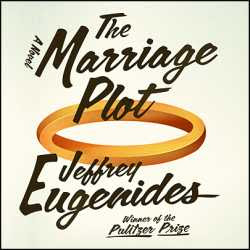12.09.2011
The Marriage Plot
There is no happiness in love except at the end of the English novel. Jeffrey Eugenides
There are many strands running through Jeffrey Eugenides new novel, The Marriage Plot—the future of the novel, the meaning of love, and the quest for religious insight. Two others loomed large for me—the effects of reading fiction and the power of manic-depression.
The scene is 1982, the place is Brown University, the characters are three graduating seniors, Madeleine Hanna, an English major and her two suitors Leonard Bankhead, a handsome, talented student of semiotics and Mitchell Grammaticus, a prospective theology student, also talented, but struggling to compete with Leonard for Madeleine’s affection.
The novel begins with books, the books on Madeleine’s dormitory bookshelves—the Henry James, the complete Modern Library, the many 18th and 19th century novels, the moderns, too. The novel ends with a lengthy question Mitchell poses about a half-fictional, half-realistic novel. In between, we are led to wonder whether novels are actually about “real life.”
Do books change us, what good are they for, do they have any practical use or are they simply about other books? Madeleine is seriously in love with Leonard and they are both reading Roland Barthe’s book A Lover’s Discourse in the semiotics class they are taking. Eugenides writes,
“The more of A Lover’s Discourse she read, the more in love she felt. She recognized herself on every page…Here was a book addressed to lovers, a book about being in love that contained the word love in just about every sense. And oh, how she loved it.”
No matter that Barthe’s book rejects the belief that books are “about” something. “If it was “about” anything, then it was about the need to stop thinking of books as being about things.”
Eugenides’ descriptions of Leonard’s manic-depression, as bi-polar disorder was known then, are handled so well and are precise in their accuracy. Perhaps he has experienced it, known someone who has (as I have) or read the books carefully. Regardless, the violent swings, the manic highs, the depressive helplessness, its unpredictability and the terrible effects of the drug lithium that was about the only medication used at that time seem to me thoroughly true to the “disease.”
…something crucial about depression. The smarter you were, the worse it was. The sharper your brain, the more it cut you up.…his mind kept up its play-by-play analysis of the contest under way…You can’t get clean from depression. Depression is like a bruise that never goes away. A bruise in your mind. You just got to be careful not to touch where it hurts. It always will be there, though.
In one of Madeleine’s English classes Professor Saunders, her senior thesis adviser, declares the novel, especially those devoted to the marriage plot, had reached its highpoint with the nineteenth century novel. “As far as Saunders was concerned, marriage didn’t mean much anymore, and neither did the novel.”
The pleasure of reading The Marriage Plot refutes Saunders’ claim and suggests that Eugenides is quite ready to place his bets on the classic novel. “What exquisite guilt she felt wickedly enjoying narrative…Madeleine felt safe in a nineteenth-century novel. There were going to be people in it. Something was going to happen to them in a place resembling the world.”
Does Madeleine cast her lot with the troubled Leonard or the calm and reflective Mitchell or does she give up on the idea of marriage all together? You care about these people and you want to find out what she decides even in an age where marriage seems like a thing of the past, where pre-nuptial agreements and filing for separation or divorce are routine matters.
Yes, it is still possible to develop a fine novel that is sustained by the themes of love and marriage, as if anyone ever had any doubts in the first place.
Subscribe to:
Post Comments (Atom)


No comments:
Post a Comment